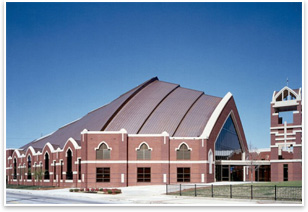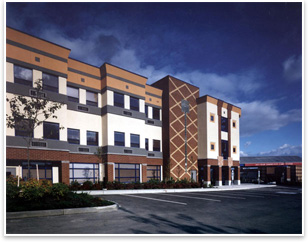
| Diversity Three Views on the Prospects of Increasing Diversity in the Profession How do you . . . entice talented persons of color to become architects? Summary: This month’s diversity column features two successful black-owned firms situated on opposite ends of the country. In Atlanta, William J. Stanley, III, FAIA, and Ivenue Love-Stanley, FAIA, are the principals in Stanley-Love Stanley, PC. In Seattle, Donald I. King, FAIA, founded DKA. Both firms have acknowledged prevailing neo-Modernist influences in their work, though they have largely eschewed the high-tech vocabulary of blobs, folds, and boxes common in the work of some younger-generation firms. Each has focused on using and transforming non-European historic influences—King from the tropics and the world of the Mayas, Stanley and Love-Stanley from Africa. Both firms boast tight links to their social and religious communities.
Profile: William J. Stanley III, FAIA and Ivenue Love-Stanley, FAIA These “firsts” identify the founders of a firm that has become one of the nation’s largest African-American practices, and includes such work as the landmark Ebenezer Baptist Church New Horizon Sanctuary (where Dr. Martin Luther King Jr.’s father was pastor), Lyke House, Turner Chapel AME Church, Fort Valley (Ga.) State University Health and Physical Education Building. Profile: Donald I. King, FAIA
King deliberately designs “outside the European model.” He looks instead to Africa, tropical, and other examples of Pre-Columbian architecture “because their climate-responsive site planning, decorative facades, and day-lit and ventilated spaces represent natural responses.” In his search for a definition of non-European-derived architecture, King has created a design vocabulary in which modern building methods and non-Western design motifs co-exist amicably to form some of the few examples of a genuine pre-colonial style of architecture. In light of the hurdles he and other black architects have had to overcome, what gives him the most satisfaction is the fact that he is a good designer with a successful practice—despite the fact that he hasn’t always played up the trendy architectural design features that win awards. Three role models speak out |
||
Copyright 2007 The American Institute of Architects. All rights reserved. Home Page |
||
news headlines
practice
business
design
recent related
› The Educators
› Young African American Women Sharpen Ties to Their Communities
› Making Partner in the Majority-Owned Practice

